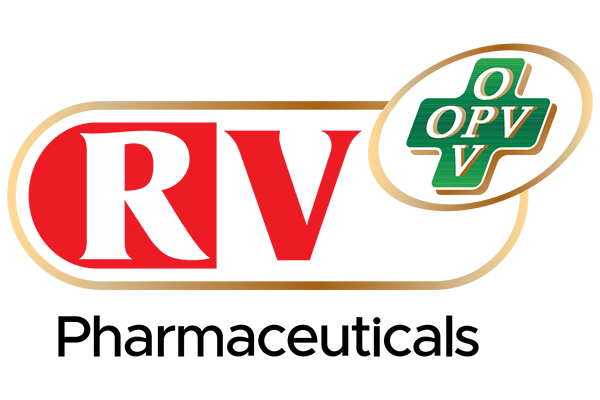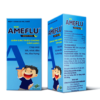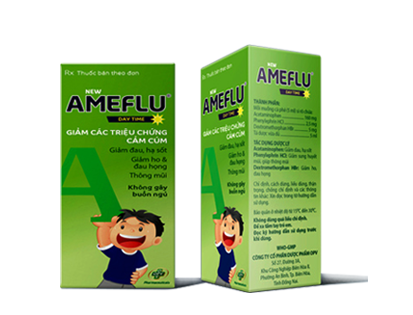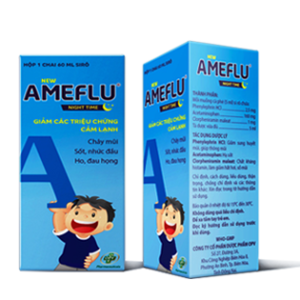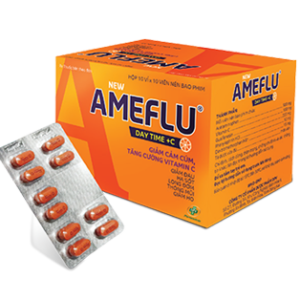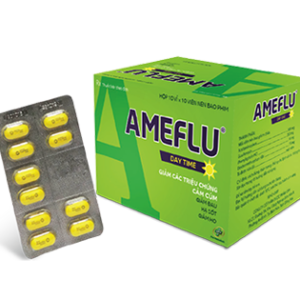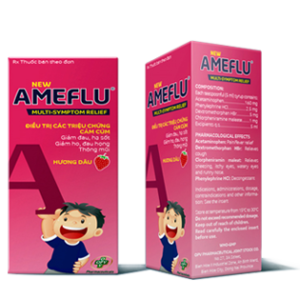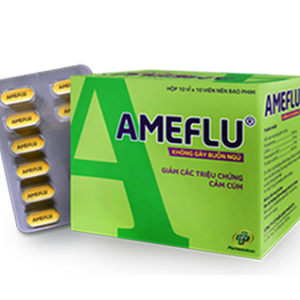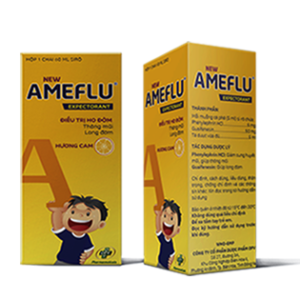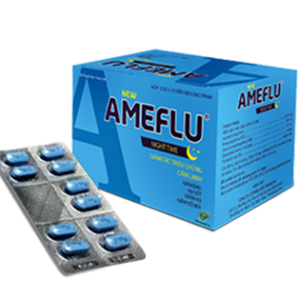COMPOSITIONS: Each 5 ml syrup contains:
Active ingredient:
Acetaminophen 160 mg
Phenylephrine HCl 2.5 mg
Dextromethorphan HBr 5 mg
Excipients: Propylene glycol, citric acid, sodium benzoate, glycerine, sorbitol 70%, polyethylene glycol 400, pineapple flavor, tartrazine, sunset yellow, sucralose, purified water.
INDICATIONS:
Temporarily relieves the common cold symptoms: Minor aches and pains, headache, sore throat, nasal congestion (stuffy), cough, sneezing and runny nose and fever.
ADMINISTRATION AND DOSAGE:
Shake well before using.
– Children from 6 to 11 years of age: take 2 teaspoons (10 ml), every 4 hours. Do not take more than 10 teaspoons (50 ml) in 24 hours.
– Children from 4 to 5 years of age: take 1 teaspoon (5 ml), every 4 hours. Do not take more than 5 teaspoons (25 ml) in 24 hours.
– Children under 4 years: directed by a doctor.
CONTRAINDICATIONS:
– The patients who are hypersensitive to any ingredients of this product.
– Children under 2 year of ages.
– Patients who are receiving MAOIs (see Drug interaction section).
– Patients who have coronary disease and severe hypertension.
– G6DP insufficiency.
– Patients with severe hepatic failure.
– Severe cardiovascular disease, myocardial infarction, atrioventricular block, severe coronary arteriosclerosis, ventricular tachycardia.
– Severe hyperthyroidism, acute angle closure glaucoma.
WARNINGS AND PRECAUTIONS:
– The doctor must warn the patients about the symptoms of serious skin reactions including: Stevens-Johnson Syndrome (SJS), toxic epidermal necrolysis (TEN), or Lyell Syndrome, acute generalized exanthematous pustulosis (AGEP).
– Children under 4 years of age.
– Do not exceed recommended dosage.
Because this medicine contains dextromethorphan HBr, take with precaution:
– Patients have cough accompanied by excessive secretions and chronic cough in the patients with smoking, asthma or emphysema.
– Patients are at risk or are impaired respiration.
– Administration of dextromethorphan may be associated with histamine release, and the drug should be used with caution in atopic children.
– Abuse and recreational use of dextromethorphan may occur (although rare), especially due to prolonged high doses.
Ask doctor before use it if children have
– Liver disease, heart disease, high blood pressure, thyroid disease, diabetes.
– Persistent or chronic cough such as occurs with asthma.
– Cough that occurs with too much phlegm (mucus).
– Trouble urinating due to an enlarged prostate gland.
Ask a doctor or pharmacist before use if your child is taking the anticoagulant drug warfarin.
Stop use and ask a doctor if:
– Nervousness, dizziness or sleeplessness occur.
– Pain or nasal congestion gets worse or lasts more than 5 days.
– Fever gets worse or lasts more than 3 days.
– Redness or swelling is present.
– New symptoms occur.
– Cough comes back or occurs with rash or headache that lasts.
These could be signs of a serious condition.
This drug contains:
– Sorbitol. Patients with rare hereditary problems of fructose intolerance should not take this drug.
– Propylene glycol. May cause alcohol – like symptoms.
– 1.95 mg of sodium benzoate per 1 ml of syrup. Sodium benzoate increase in bilirubinaemia following its displacement from albumin may increase neonatal jaundice which may develop into kernicterus (non-conjugated bilirubin deposits in the brain tissue).
– Tartrazine, sunset yellow which may cause allergic reactions.
– Polyethylen glycol 400 which may cause allergic reactions, bowel obstruction (nausea, vomiting, abdominal pain or distention).
Pregnancy: Only use this medicine in pregnancy if clearly neccessary, with consideration on harmful effects of the medicine. Not recommended in pregnant women in the first 3 months of pregnancy due to drug containing phenylephrine HCl.
Breast-feeding: Be cautious when using the drug in breast-feeding women, consider stopping breast-feeding or stop taking this medicine, depending on the importance of the medicine to the mother.
Effects on the ability to drive and use machines: This medicine can cause fatigue, dizziness, headache, anxiety, weakness, should be used with caution when driving or operating machinery.
SIDE EFFECTS:
Common, ADR>1/100
Fatigue, dizziness, flushing, headache, nervousness or anxiety, trouble sleeping, weakness.
Uncommon, 1/1000<ADR<1/100
Rash, urticaria, nausea, vomiting, blood dyscrasias (neutropenia, reducing blood cells, leukopenia), anemia, kidney disease, renal toxicity after using medicines in long term, hypertension accompanied by edema, arrhythmia, bradycardia, peripheral vasoconstriction, respiratory depression, euphoria, hallucinations, paranoia, necrosis skin or desquamating skin, releasing the pigmens in the iris, cornea blurs.
Rare, ADR<1/1000
Gastrointestinal disturbances, abnormal behavious, inhibition of CNS and respiratory depression, hypersensitivity reactions, myocardium inflammation, seizures, stomach pain, tremor, yellowing of skin or eyes.
In case of an unexpected reaction, consult your physician.
INTERACTIONS:
– Do not take this product if your child is now taking a prescription of monoamine oxidase inhibitor (MAOI) (certain drugs for depression, psychiatric or emotional conditions, or parkinson’s disease), or for 2 weeks after stopping the MAOI drug. If you do not know if your child’s prescription drug contains an MAOI, ask a doctor or pharmacist before taking this product.
– Phenytoin, barbiturate, carbamazepin, isoniazid may increase the hepatotoxicity of Acetaminophen.
– Concomitant use of phenylephrine with other sympathomimetic amines can increase the risk of cardiovascular side effects.
– Phenylephrine may reduce the efficacy of beta-blocking drugs and antihypertensive drugs (including debrisoquine, guanethidine, reserpine, methyldopa). The risk of hypertension and other cardiovascular side effects may be increased.
– Tricyclic antidepressants (e.g. amitriptyline, imipramine): May increase the risk of cardiovascular side effects with phenylephrine.
– Concomitant use of phenylephrine with ergot alkaloids (ergotamine and methylsergide): Increase the risk of ergotism.
– Concomitant use of phenylephrine with digoxin: Increase the risk of irregular heartbeat or heart attack.
– Concomitant use of phenylephrine with atropine will block the reflex bradycardia that phenylephrine causes.
– Concomitant use of dextromethorphan and CNS inhibitors may increase the CNS inhibition of these drugs.
– Quinidine inhibits cytochrome P450 2D6 and markedly increases the plasma levels of dextromethorphan which causes increased side effects of dextromethorphan.
OVERDOSE AND TREATMENT:
Acetaminophen:
Symptoms: Nausea, vomiting and abdominal pain (normally settle within 24 hours of ingestion). After 24 hours symptoms may include right subcostal pain and tenderness, usually indicates development of hepatic necrosis. Liver damage is greatest 3-4 days after ingestion and may lead to encephalopathy, haemorrhage, hypoglycaemia, cerebral oedema and death.
Treatment: Treatment is based on plasma concentration. Acetylcysteine protects the liver if administered within 24 hours after ingestion (most effective if given within 8 hours). Dose: 140 mg/kg orally (loading) followed by 70 mg/kg every 4 hours for 17 doses. Activated charcoal or gastric lavage may be treated to decrease absorption of Acetaminophen.
Phenylephrine HCl:
Symptoms: Hypertension, headache, convulsions, cerebral haemorrhage, palpitation, slow heart rate.
Treatment: Should provide symptomatic and supportive care.
Dextromethorphan:
Symptoms: Nausea, vomiting, somnolence, blurred vision, nystagmus, urinary retention, euphoria, hallucination, ataxia, respiratory failure and convulsion.
Treatment: Symptomatic and supportive treatment, can administer intravenous injection of naloxon 2 mg, to be repeat if necessary.
PRESENTATION:
Bottle of 60 ml, bottle of 30 ml
STORAGE:
Store at temperature from 15oC to 30oC.
SHELF-LIFE:
36 months from manufacturing date. Do not use after expiry date.
DATE OF REVISION OF PACKAGE INSERT:
KEEP OUT OF REACH OF CHILDREN
READ THE ENCLOSED INSERT CAREFULLY BEFORE USE
DO NOT EXCEED RECOMMENDED DOSAGE
FOR FURTHER INFORMATION, CONSULT YOUR PHYSICIAN
OPV PHARMACEUTICAL JOINT STOCK COMPANY
WHO-GMP
No. 27, 3A Street, Bien Hoa II Industrial Zone, An Binh Ward, Bien Hoa City, Dong Nai Province.
Tel : (061) 3992999 Fax: (061) 3835088

